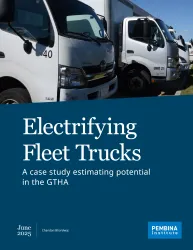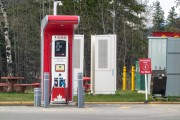Every day, thousands of trucks and vans crisscross Canada to deliver the goods we rely on — from food and medicine to building materials and packages. This constant flow of goods keeps our economy humming.
But the system powering it is showing cracks. Canada’s delivery fleets run almost entirely on fossil fuels — and the costs are adding up. The pollution they generate contributes to thousands of asthma attacks, respiratory illnesses and even premature deaths each year. The burden on our healthcare system? An estimated $9.5 billion annually.
At the same time, our ability to compete in the global clean economy is slipping. Canada now produces 40% fewer medium- and heavy-duty vehicles than it did just a decade ago. In Ontario — once a hub of truck manufacturing — the sector has shrunk to just one-tenth of its former size, still anchored in diesel-based technologies as the world shifts toward cleaner alternatives.
There is a better way, and it starts with electric vans and trucks.
Electric vehicles are not only more energy-efficient — but they also cut harmful local air pollution, reduce fuel and maintenance costs and boost energy security in regions like Ontario that rely heavily on imported fuel. For businesses, this means lower operating costs. For communities, it means cleaner air.
Electrification also has the potential to reinvigorate Canada and Ontario’s declining auto manufacturing sector. As global demand for electric vehicles rises, new opportunities will emerge for skilled workers in assembly, research and development and supply chain management — revitalizing a shrinking industry and fueling long-term economic growth. EV manufacturing can leverage Canada and Ontario’s strengths in the resource sector, as it opens new demand for critical minerals used in batteries — like lithium, nickel, cobalt and graphite — creating opportunities for growth at home.
The global race is on; will Ontario keep up?
Governments around the world are moving quickly. Jurisdictions across Europe, California, and 10 other U.S. states, along with British Columbia and Quebec, have set (or are considering) ambitious targets: roughly 35% of new medium- and heavy-duty sales must be zero-emission by 2030, ramping up to nearly 100% by 2040. In Ontario, the provincial government’s Driving Prosperity plan recognizes electrification as a cornerstone of future competitiveness. And cities like Toronto are aiming for 30% of all registered vehicles to be electric by 2030.
Electric trucks are ready for Ontario roads.
The technology is here and its scaling quickly. The electric truck market is expected to grow from $29.7 billion in 2024 to $124.97 billion by 2030. And many of Ontario’s trucks are ready to make the switch today. Our analysis shows that, based on real-world driving patterns and the capabilities of electric vehicles already on the market, a significant share of trucks and vans in the Greater Toronto and Hamilton Area can switch from diesel to electric. We don’t need to wait for better batteries or more advanced models. The vehicles exist. The business case is growing. The shift can start now.
So, what does the data tell us?
We dug into vehicle data across the Greater Toronto and Hamilton Area, and here is what we found:
- Battery range is not the barrier people think it is. Today’s electric trucks can already meet the daily needs of most Class 3 to 8 vehicles in the Greater Toronto and Hamilton Area, even in cold weather conditions when battery performance drops by up to 30%.
- We don’t need to wait for a full public network to get started. Roughly 40% of Class 3 to 8 trucks in the region could rely almost entirely on electric chargers installed at their home base. That means, while charging infrastructure deployment is critical for some freight vehicles use cases, Ontario can move forward now on electrifying many freight truck use cases and doesn’t need to wait until a full public charging network is in place to get started.
Electrification potential grows significantly over time. In the next two to three years, we could swap out more than a third of Class 3 trucks, one in five Class 4 and 5 trucks, and even 10% of the biggest trucks on the road. That’s a significant portion of the freight fleet that could go electric today, using models already on the market.
Class 3 and smaller vehicles make up over two-thirds of all vans and trucks in Canada and in Ontario. This means that a large share of the market is already within reach for electrification.
That’s just the beginning. Between 2028 and 2034, the potential grows substantially. Nearly 60% of Class 3 trucks could go electric, around half of Class 4 and 5 vehicles and more than a third of Class 6 to 8 trucks.
Beyond 2035, if technology continues to improve and adoption ramps up, up to 90% of Class 3 vehicles and more than two-thirds of even the heaviest trucks could be replaced with electric models — with potential for even higher uptake under optimistic scenarios.
Smart policy can make electrification real.
If Ontario implemented data-driven, strategically designed policies that reflect differences in market readiness across truck classes, the Greater Toronto and Hamilton Area, which holds over half of the province’s vehicle stock, could reach 35% zero-emission vehicle sales by 2030. A staggered approach would make this feasible by targeting 50% sales for lighter-duty Class 3 and 4 vehicles, while setting more modest goals (under 10%) for heavier Class 5 to 8 trucks. To lead this transition and keep Ontario-based fleets competitive, the province can act by supporting small- and medium-sized businesses, coordinating with utilities to accelerate charger deployment, standardizing charging equipment and ensuring fair, cost-effective electricity rates.
It’s time for Ontario to lead.

The path to electrification is both promising and feasible. With the right mix of policies and strategies, Ontario can accelerate the shift to electric trucks, drive economic growth and build healthier, more resilient communities. Our report, Electrifying Fleet Trucks, shows what’s possible today based on real-world industry data. What’s needed now is the political will to act.
Dig into the details
- Dive into our key findings and report to understand which segments of the market are ready for electrification and where targeted efforts can drive progress.
- And for insights on how to expand charging infrastructure for medium- and heavy-duty vehicles across Ontario, review our report Helping Fleets Charge.
- Stay tuned for the next phase of our work, where we will dig deeper — mapping priority zones for public charging infrastructure across the Greater Toronto and Hamilton Area, right down to the forward-sortation-area level. These insights will help guide smart, targeted investments to maximize impact and accelerate the transition to electric freight.







